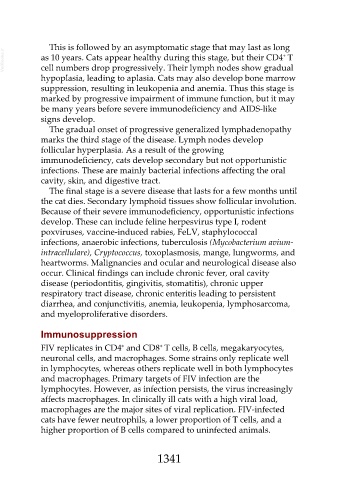Page 1341 - Veterinary Immunology, 10th Edition
P. 1341
This is followed by an asymptomatic stage that may last as long
VetBooks.ir as 10 years. Cats appear healthy during this stage, but their CD4 T
+
cell numbers drop progressively. Their lymph nodes show gradual
hypoplasia, leading to aplasia. Cats may also develop bone marrow
suppression, resulting in leukopenia and anemia. Thus this stage is
marked by progressive impairment of immune function, but it may
be many years before severe immunodeficiency and AIDS-like
signs develop.
The gradual onset of progressive generalized lymphadenopathy
marks the third stage of the disease. Lymph nodes develop
follicular hyperplasia. As a result of the growing
immunodeficiency, cats develop secondary but not opportunistic
infections. These are mainly bacterial infections affecting the oral
cavity, skin, and digestive tract.
The final stage is a severe disease that lasts for a few months until
the cat dies. Secondary lymphoid tissues show follicular involution.
Because of their severe immunodeficiency, opportunistic infections
develop. These can include feline herpesvirus type I, rodent
poxviruses, vaccine-induced rabies, FeLV, staphylococcal
infections, anaerobic infections, tuberculosis (Mycobacterium avium-
intracellulare), Cryptococcus, toxoplasmosis, mange, lungworms, and
heartworms. Malignancies and ocular and neurological disease also
occur. Clinical findings can include chronic fever, oral cavity
disease (periodontitis, gingivitis, stomatitis), chronic upper
respiratory tract disease, chronic enteritis leading to persistent
diarrhea, and conjunctivitis, anemia, leukopenia, lymphosarcoma,
and myeloproliferative disorders.
Immunosuppression
+
+
FIV replicates in CD4 and CD8 T cells, B cells, megakaryocytes,
neuronal cells, and macrophages. Some strains only replicate well
in lymphocytes, whereas others replicate well in both lymphocytes
and macrophages. Primary targets of FIV infection are the
lymphocytes. However, as infection persists, the virus increasingly
affects macrophages. In clinically ill cats with a high viral load,
macrophages are the major sites of viral replication. FIV-infected
cats have fewer neutrophils, a lower proportion of T cells, and a
higher proportion of B cells compared to uninfected animals.
1341

